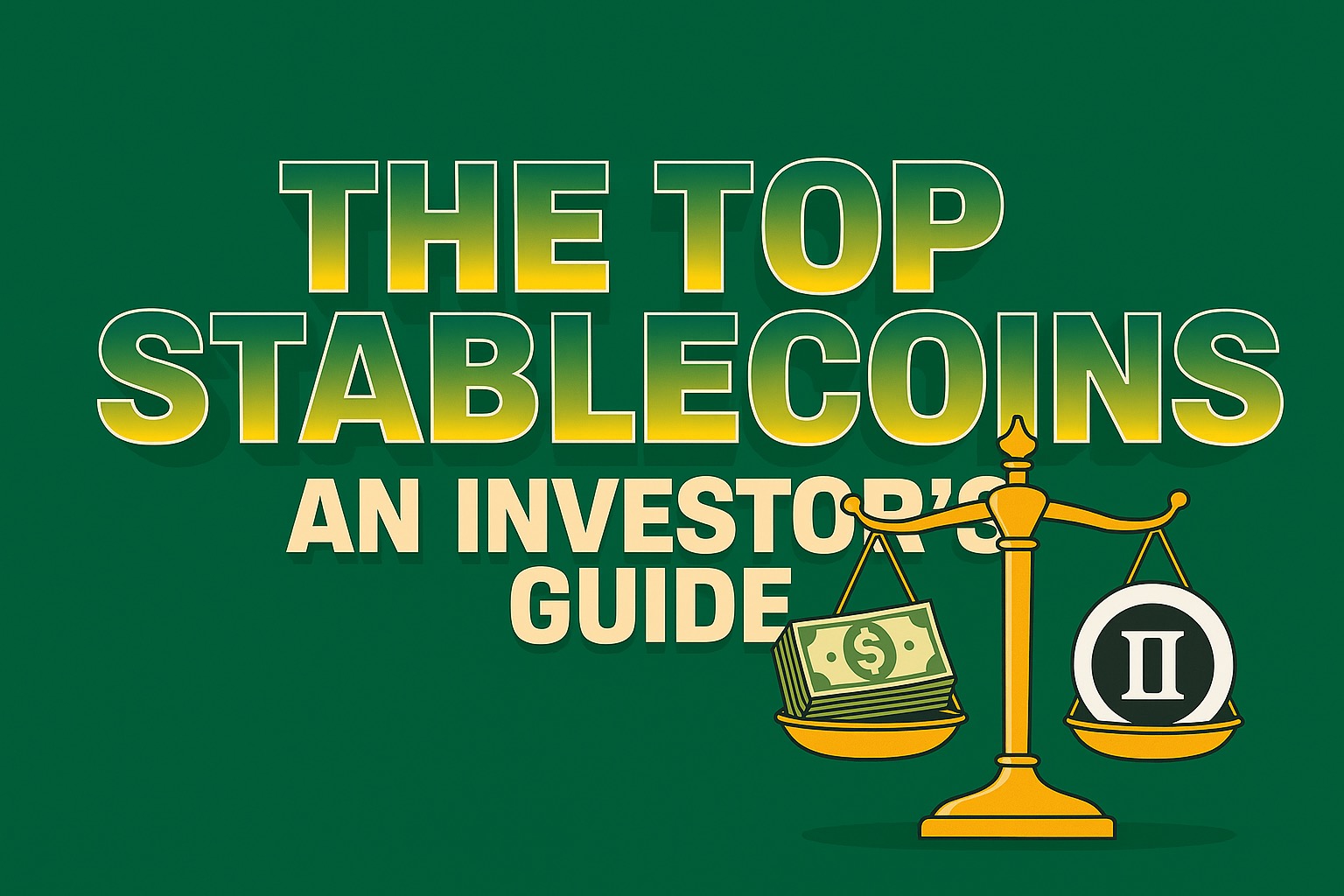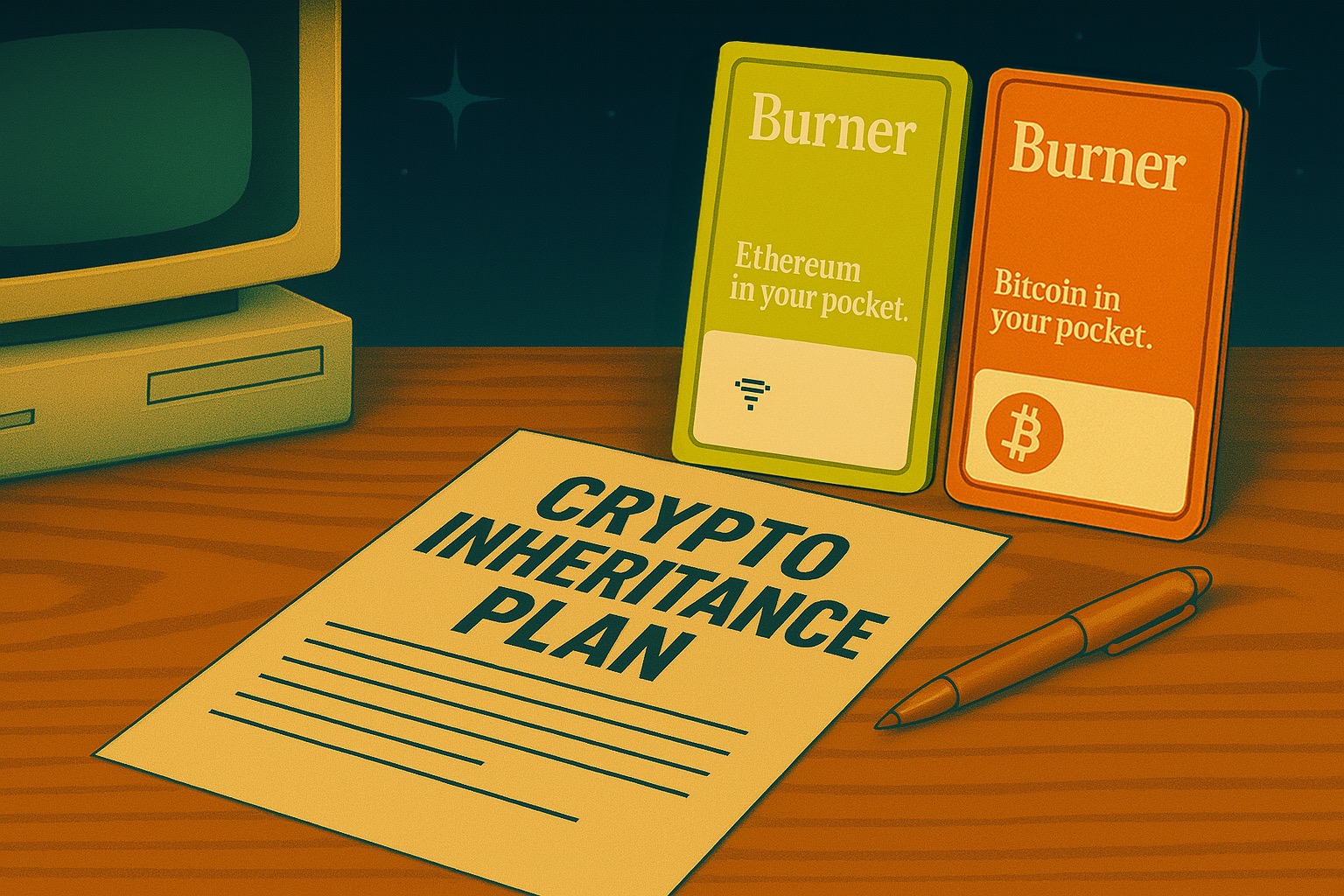Top Stablecoins of 2025: An Investor's Guide
Back to articles
For every $100 USD II you onramp, receive a free Burner—a secure, seedless hardware wallet built for gifting, saving, and everyday crypto use.
(Limit: 10 free Burners per person.)
Claim your free wallet(s) ↗ or read on to see why Burner is the best choice for storing stablecoins.
Stablecoins are a foundation of the modern crypto ecosystem, helping investors and everyday users manage volatility, access DeFi, and move money with less friction. But not all stablecoins are created equal. In this guide, you’ll find what makes each leading stablecoin stand out in 2025, along with strategic insights, use cases, and how options like USD II are redefining utility and everyday ease.
Stablecoins 101
Designed to mirror the value of real-world assets, stablecoins are digital assets pegged to stable references like fiat currencies, commodities, or crypto assets. Unlike volatile cryptocurrencies such as Bitcoin, they serve as a reliable medium of exchange and avoid rapid price fluctuations. The main types of stablecoins include:
These are pegged to traditional currencies and backed by reserves held by trusted custodians. They dominate the stablecoin market and are used for gifting, payments, and cross-border payment.
These use other crypto assets (like ETH) as collateral. They’re often overcollateralized to reduce volatility risks.
These are tied to physical assets like gold. Investors often use them to retain stability while diversifying into commodities.
These use smart contracts to expand or contract supply based on demand. However, as seen with TerraUSD’s collapse, algorithmic stablecoins can carry major potential risks.
These adjust value based on inflation or cost-of-living indexes instead of fiat. They help protect long-term purchasing power for crypto users.
Market Snapshot: Key Numbers for Investors

In 2025, stablecoins in circulation have reached a market capitalization of $246 billion, highlighting widespread adoption. According to data from Visa, daily crypto transactions involving stablecoins approach $710 billion, with annual transfers surpassing $8 trillion, underlining their critical role in the cryptocurrency market and traditional finance. Institutional demand for stablecoins is also growing significantly, particularly for maintaining financial stability and hedging against market volatility.
Top 10 Stablecoins of 2025 (Ethereum & Base)
Curious how the leading stablecoins stack up? The following chart gives you a direct comparison of the top options and what sets each apart.
How to buy USD II:
- Open the USD II app in BurnerOS and follow the onramp instructions.
How to swap for other stablecoins:
- Open BurnerOS and tap Swap.
- Select the network (Base or Ethereum) for your target stablecoin.
- Paste the stablecoin’s contract address into the swap field.
- Enter the amount and confirm.
| Stablecoin | Symbol | Chains Supported | Type | Why Consider It? | Contract Address |
|---|---|---|---|---|---|
| USD II | USD2 | Base | Fiat-backed | Gas-free swaps and transfers, built for seamless everyday use and gifting with BurnerOS, backed by Stripe/Bridge | 0xfe26e72431Bd82c285655e897F25104E547c4c07 |
| USD Coin | USDC | Ethereum, Base | Fiat-backed | Widely supported, gas-free transfers within Coinbase Wallet |
0xa0b86991c6218b36c1d19d4a2e9eb0ce3606eb48 (Ethereum) 0x833589fCD6eDb6E08f4c7C32D4f71b54bdA02913 (Base) |
| Tether | USDT | Ethereum | Fiat-backed | Global leader in liquidity and network support, but with ongoing questions around transparency | 0xdac17f958d2ee523a2206206994597c13d831ec7 |
| PayPal USD | PYUSD | Ethereum | Fiat-backed | Native to PayPal, easy on/off ramp for those already using PayPal | 0x6c3ea9036406852006290770bedfcaba0e23a0e8 |
| DAI | DAI | Ethereum | Crypto-backed | Decentralized, long-time favorite in DeFi—though not always gas-efficient | 0x6b175474e89094c44da98b954eedeac495271d0f |
| TrueUSD | TUSD | Ethereum | Fiat-backed | Regular third-party attestations | 0x0000000000085d4780b73119b644ae5ecd22b376 |
| First Digital USD | FDUSD | Ethereum | Fiat-backed | Regulated in Asia | 0xc5f0f7b66764f6ec8c8dff7ba683102295e16409 |
| Ethena USDe | USDe | Ethereum | Algorithmic | Capital-efficient, with built-in yield strategies—but users should understand algorithmic risks | 0x4c9edd5852cd905f086c759e8383e09bff1e68b3 |
| Ripple USD | RLUSD | Ethereum | Fiat-backed | Enterprise-grade payments, fast settlement—ideal for those already in the Ripple ecosystem | 0x8292bb45bf1ee4d140127049757c2e0ff06317ed |
| PAX Gold | PAXG | Ethereum | Commodity-backed | Tokenized gold for those wanting a hedge against fiat, with on-chain convenience | 0x45804880de22913dafe09f4980848ece6ecbaf78 |
| sUSD | sUSD | Ethereum | Crypto-backed | Synthetic USD, core to the Synthetix DeFi ecosystem—best for advanced DeFi users | 0x9d39a5de30e57443bff2a8307a4256c8797a3497 |
| World Liberty Financial USD | USD1 | Base | Fiat-backed | Political branding | 0x8d0d000ee44948fc98c9b98a4fa4921476f08b0d |
| Rai Reflex Index | RAI | Ethereum | Flatcoin | Inflation-resistant, non-USD pegged, and decentralized | 0x03ab458634910aad20ef5f1c8ee96f1d6ac54919 |
| Legacy Frax Dollar | FRAX | Ethereum | Algorithmic | Long DeFi history, once a leading fractional stablecoin | 0x853d955acef822db058eb8505911ed77f175b99e |
| Euro Coin | EURC | Ethereum | Fiat-backed | Euro exposure, fully reserved and regulated, for those seeking alternatives to USD stablecoins | 0x1abaea1f7c830bd89acc67ec4af516284b1bc33c |
Stablecoin Breakdown: What Sets Each Coin Apart
Whether you’re holding for investment, payments, or gifting, storing your digital assets safely matters. Burner wallet makes secure, seedless hardware storage simple and accessible for everyday use.
Get your Burner today.
From everyday payments to secure, long-term storage, here’s how the top stablecoins compare—so you can choose the option that makes managing, spending, or gifting digital dollars as simple and secure as possible.
USD II (USD2)

USD II is a fiat-backed stablecoin built for everyday payments and frictionless crypto gifting—no app installs or seed phrases required. Issued on Base and backed 1:1 by U.S. dollars and treasury reserves (held by Bridge, acquired by Stripe), USD II works seamlessly with BurnerOS and is secured by your physical Burner card.
Every transfer and swap within BurnerOS is gas-free, making sending, spending, and gifting effortless. USD II can be redeemed for U.S. dollars through Bridge and is accepted at Flexa-enabled merchants for real-world purchases.
Key benefits:
- Gas-free transfers, swaps, and gifting
- Instant onboarding, no complex setup
- Hardware wallet security, no recovery phrases
- Redeem for USD or spend at Flexa merchants
USD II is perfect for anyone who wants practical, stable digital dollars for everyday use or as a gift.
Issuer: Burner (with partner Bridge)
Contract address: 0xfe26e72431Bd82c285655e897F25104E547c4c07
USD Coin (USDC)

USD Coin is a fiat-backed stablecoin widely used on Ethereum and Base. It’s broadly supported across wallets and exchanges. USDC transfers within Coinbase Wallet are gas-free, but USDC swaps incur fees.
Issuer: Circle
Contract address (Ethereum): 0xa0b86991c6218b36c1d19d4a2e9eb0ce3606eb48
Contract address (Base): 0x833589fCD6eDb6E08f4c7C32D4f71b54bdA02913
Tether (USDT)

Tether is a fiat-backed stablecoin known for global liquidity and wide network support. It is popular for trading, though some transparency questions remain.
PayPal USD (PYUSD)

PayPal USD is issued by PayPal and Paxos, offering a familiar option for PayPal users. It features simple on/off ramps within the PayPal ecosystem.
Issuer: PayPal (with partner Paxos)
Contract address: 0x6c3ea9036406852006290770bedfcaba0e23a0e8
DAI

DAI is a decentralized, crypto-collateralized stablecoin widely used in DeFi. It’s backed by excess collateral but can be less gas-efficient for everyday transactions.
TrueUSD (TUSD)

TrueUSD is a fiat-backed stablecoin focused on transparency. It features regular third-party attestations of its reserves.
Issuer: Archblock (formerly TrustToken)
Contract address: 0x0000000000085d4780b73119b644ae5ecd22b376
First Digital USD (FDUSD)

Ethena USDe is an algorithmic stablecoin designed for capital efficiency and yield strategies in DeFi. As with all algorithmic coins, users should understand associated risks.
Issuer: First Digital Labs
Contract address: 0xc5f0f7b66764f6ec8c8dff7ba683102295e16409
Ethena USDe (USDe)

Ethena USDe is an algorithmic stablecoin designed for capital efficiency and yield strategies in DeFi. As with all algorithmic coins, users should understand associated risks.
Ripple USD (RLUSD)

Ripple USD is a fiat-backed stablecoin linked to Ripple’s payment network. It is mainly used for fast settlements within the Ripple ecosystem.
PAX Gold (PAXG)

PAX Gold is a commodity-backed token tied to physical gold. It offers blockchain convenience for those seeking gold exposure.
sUSD

sUSD is a synthetic, crypto-collateralized stablecoin central to the Synthetix DeFi protocol. It’s most useful for advanced DeFi users and derivatives trading.
World Liberty Financial USD (USD1)

World Liberty Financial USD is a fiat-backed stablecoin known for its political branding as the “Trump Dollar.” It has attracted controversy for its associations and ongoing regulatory questions.
Issuer: World Liberty Financial
Contract address: 0x8d0d000ee44948fc98c9b98a4fa4921476f08b0d
Rai Reflex Index (RAI)

RAI is a flatcoin—non-USD-pegged and governed by algorithmic rules. It is favored by users seeking inflation-resistant, decentralized value.
Legacy Frax Dollar (FRAX)

Legacy Frax Dollar pioneered the fractional-algorithmic stablecoin model. It is now a legacy asset, notable for its historical innovation in DeFi.
Euro Coin (EURC)

Euro Coin is a euro-pegged, fiat-backed stablecoin issued by Circle. It is designed for those needing euro-denominated payments or exposure in DeFi.
Strategic Investment Insights

Beyond just holding stablecoins, investors in 2025 are finding new ways to put these assets to work. From yield generation and lending to seamless cross-border transfers, today’s stablecoins unlock practical strategies that go far beyond holding for price stability alone. Here’s how savvy investors are using stablecoins right now:
Trading and liquidity management: Stablecoins help crypto users lock in gains, manage risk, and move seamlessly between assets—without needing to cash out to fiat currency during volatile market swings.
DeFi lending and borrowing: Investors can use stablecoins as collateral or to access loans in decentralized finance protocols, enabling flexible access to liquidity and leverage while maintaining exposure to the broader crypto market.
Yield generation: Many investors put stablecoins to work in DeFi platforms for yield farming and liquidity provisioning, earning passive income while maintaining price stability.
Portfolio diversification: With exposure to fiat currencies, commodities, and algorithmic mechanisms, stablecoins enable broader asset allocation within the crypto market.
These core applications have fueled the widespread adoption of stablecoins across exchanges, DeFi protocols, and global payment rails, making them indispensable for anyone participating in the digital asset economy.
Additional Use Cases
Gifting Crypto: Stablecoins like USD II simplify crypto gifting by enabling gas-free transactions. They make it straightforward to introduce newcomers to digital currencies, removing complexity and enhancing user experience. Learn more about gifting crypto with USD II.
Cross-border Transactions: Stablecoins are an attractive option for international payments, significantly reducing the fees associated with bank transfers. Particularly beneficial in regions such as Latin America and Southeast Asia, stablecoins enhance financial inclusion by offering efficient and accessible cross-border payment options.
Regulatory Environment: Quick Overview

Regulatory developments are playing an increasingly decisive role in the growth and adoption of stablecoins. In Europe, the Markets in Crypto-Assets (MiCA) regulation requires stablecoins to maintain a strict 1:1 asset backing and robust reserve management, boosting investor confidence and market stability. In the United States, lawmakers are moving closer to enacting clear stablecoin issuer guidelines—such as the recently passed GENIUS Act—aimed at strengthening transparency, consumer protections, and reserve requirements . Across Asia, innovative sandbox regulatory frameworks, such as Hong Kong’s upcoming Stablecoin Issuer Sandbox, are encouraging stablecoin experimentation and supporting responsible financial innovation.
How the Global Regulatory Landscape Shapes the Market:
Europe: MiCA mandates full 1:1 backing for fiat-backed stablecoins, increasing transparency and investor protections.
U.S.: Regulatory proposals focus on issuer registration, transparency, and robust reserve asset management.
Asia: Hong Kong and Singapore are at the forefront of regulatory sandboxes, creating supportive environments for stablecoin growth and broader adoption.
Future Trends to Watch
Looking ahead, investors should anticipate continued innovation in programmable stablecoins that can be automated for advanced financial products and services. As adoption accelerates across Layer 2 solutions like Base, efficiency will increase and transaction costs will decrease. Meanwhile, the institutional embrace of stablecoins for use in enterprise finance, such as for payroll, invoicing, and cross-border settlements is cementing their role in the future of global payments.
Why Stablecoins Are Poised for Growth:
Increasing integration with both decentralized and centralized crypto exchanges.
Expanding use in everyday payments and digital financial systems.
Growing adoption by institutional and private investors for business operations, payroll, and cross-border transactions.
Final Thoughts
Stablecoins have become indispensable digital assets, offering investors lower volatility, greater access to financial systems, and practical benefits across both traditional finance and the evolving crypto ecosystem. USD II, integrated with BurnerOS, continues to set itself apart with gas-free transfers and swaps, trusted reserves, and broadening adoption.
Disclaimer: This article provides informational content only. Always perform your own research before investing.
FAQ: Investing in Stablecoins
❓ What are stablecoins and why are they important?
Stablecoins are digital assets designed to maintain a stable value by being pegged to fiat currencies (like the US dollar), commodities, or other assets. They’re essential for managing volatility, making payments, and moving funds across crypto networks without wild price swings.
For example, USD II is a stablecoin backed 1:1 by U.S. dollars and treasuries (held by Bridge), providing a practical way to store and transfer digital dollars onchain.
❓ Are all stablecoins equally secure or reliable?
No. Stability and reliability depend on how each coin is backed, the quality of its reserves, and the transparency of its issuer. Always research whether a stablecoin is fully backed by real assets.
For example, USD II is backed 1:1 by U.S. dollars and treasuries (held by Bridge), making it fundamentally different from stablecoins with less clear or riskier collateral.
❓ What makes USD II different from other stablecoins?
USD II is built for everyday payments and easy gifting on Base, with no seed phrases, no app installs, and gas-free transfers and swaps within BurnerOS. It’s fully backed 1:1 by U.S. dollars and treasuries (held by Bridge), and can be redeemed for cash or spent at Flexa merchants.
❓ Can I trust that USD II is really backed by dollars? Yes. USD II is fully backed 1:1 by U.S. dollars and treasuries, held by Bridge, with regular audits and transparent reporting. Be wary of stablecoins that don’t offer independent proof of reserves.
❓ What fees should I expect with stablecoins?
Many stablecoins charge gas fees for transfers and swaps. USD II is different: all transfers and swaps within BurnerOS on Base are gas-free. Always check if your wallet or network adds extra costs.
❓ Are stablecoins regulated?
Regulation is evolving fast. USD II and other leading stablecoins increasingly comply with strict rules on asset backing and transparency. Always check if a stablecoin is supported by a reputable issuer and regulated where you live.

Get your Burner
What to read next
Back to articlesHow to Bridge Ethereum to Base: The Complete Guide (2025)
Bridging ETH to Base is the fastest way to access low-cost, high-speed Ethereum transactions. This guide explains how blockchain bridges work, what to consider when choosing one, and how to bridge securely using your Burner wallet. Learn how to minimize gas fees, avoid common pitfalls, and start exploring dApps on Base in minutes.
Burner Terminal: Tap to Pay for Stablecoins
Burner Terminal is the first point-of-sale built for native tap to pay stablecoin payments. Designed for small businesses everywhere, it makes accepting crypto as easy as tapping a card or scanning a QR code. Simple, fast, and secure, Burner Terminal brings the benefits of cash to digital payments without chargebacks, high fees, or complexity.
Don’t Let Your Crypto Die With You: Burner Makes Inheritance Simple
Crypto inheritance has often been overlooked. It’s complicated to plan, easy to lose, and impossible to recover without the right keys. Burner makes it simple. Designed for real-world handoff, Burner replaces fragile recovery phrases with a secure PIN and a physical device you can safely store, back up, and pass on. This guide explains why traditional wallets fall short, how Burner solves the inheritance problem, and what steps you can take today to ensure your digital assets aren’t lost tomorrow.


